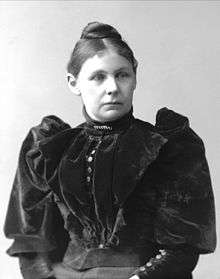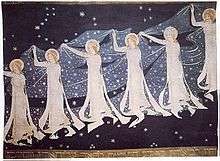Frida Hansen
| Frida Hansen | |
|---|---|
 Hansen in 1896 | |
| Born |
Frederikke Boletta Petersen March 8, 1855 Hillevåg, Stavanger, Norway |
| Died |
March 12, 1931 Oslo, Norway |
| Nationality | Norwegian |
| Known for | Textile art, tapestries |
| Movement | Art Nouveau |
Frida Hansen (born Frederikke Boletta Petersen, born March 8, 1855 in Hillevåg in Stavanger, died 12 March 1931 in Oslo) was a Norwegian tapestry maker in the Art Nouveau style. She is described as a bridge between Norwegian and European tapestry, and several of her weaving designs considered among the best made in recent European textile art. Works of Frida Hansen are in possession of a number of museums, including at the National Museum - Museum of Applied Art in Oslo, Drammen Museum, Stavanger Art Museum and the Nordic Museum in Stockholm.[1]
Early life
Frida Hansen's parents were Mathilde F Helliesen (1824-1915) and Peter Sickerius Petersen (1811-1875), a merchant and ship owner.[1]
Before she married Frida was determined to be a painter, and she received drawing and painting lessons from Bernhard Hanssen, Kitty Kielland and Johan Bennetter. In 1873, Frida married merchant Hans Wilhelm Severin Hansen Stavanger, the brother of the painter Carl Sundt-Hansen. When the father of Frida died in 1875 the couple moved into Köhlerhuset in Hillevåg. Frida was eagerly engaged in building a garden on the property.
In 1888 the city was hit by an economic downturn, and the family business Plough & Sundt that Hans Wilhelm ran, went bankrupt. The husband fled abroad for a few years, and Frida was left with sole responsibility for the family. Two of her three children died. In order to obtain an income, she started an embroidery business in her own home. In the embroidery shop old tapestries were repaired and from doing that repair work she became interested in the ancient techniques that were used to create the images.
In 1889 she was a participant in the first course in weaving in the country, hosted by Randi Blehr in Laerdal in Sogn. When the introductory course was given Frida Hansen acquired a Oppstad loom, and she quickly began to create her own images. After a short time she started selling tapestries, and she also had exhibitions in several Norwegian cities. In May 1892 Frida moved to Oslo and founded there a "Atelier for national Tæppevæving", complete with a dyeing workshop. Her knowledge about dyeing yarn was the basis for the yarn Husfliden had for sale.
Study abroad
In the spring of 1895 Frida Hansen was able to go studying abroad, first to Cologne to study medieval art and then to Paris to study life drawing. The impetus she brought from abroad was crucial to her development. In Europe, the prevailing art movement was in the process of change from the national and tradition-bound to Symbolism and Art Nouveau (Jugendstil).
The Norwegian Billedvæveri

In the period 1897 - 1906 Frida Hansen ran the workshop The Norwegian Billedvæveri who mainly worked out of her patterns. At the workshop Frida did both drawing, weaving and teaching. At the World Exhibition in Paris in 1900 Frida Hansen was awarded Gold Medal for her carpet The Milky Way. The carpet was already purchased for the Museum für Kunst und Gewerbe Hamburg. Experimental techniques led to a special transparent weave, which Frida patented. This technique was used to create porters or room dividers.
After the turn of the century, Art Nouveau gradually went out of fashion, and by 1920 the art of Frida Hansen was no longer as much in demand. In 1915 Frida Hansen received the King's Medal of Merit in gold for her work as a textile artist. From 1926 until her death in 1931 Frida Hansen worked on the Olav carpet, hanging in the porch in Stavanger Cathedral . Frida Hansen died in Oslo 12 March 1931. She is buried at the cemetery Ullern .
Work
Frida Hansen's work forms a bridge between Norwegian and European tapestry. Nature was an important source of inspiration, and flowers were special to Frida. The theory of William Morris on inspiration from nature, she held high. Nature was the key, and Morris showed it conscientiously with abstraction and simplification. When Frida was to abstract a flower, she drew it straight from above or from the side, just as William had done before her. Hansen was particularly concerned that the textiles should not be woven paintings, but should have their own expression. What she and Morris had in common was respect and humility towards nature. Frida was very fond of flowers and she loved her grandmother's rose garden when she was little. The love of flowers is also found in her tapestries. She had her own expression, influenced by Morris.
Her tapestries were often blamed for not expressing Norwegian art and culture enough. And at this time in Norway, Norwegian nationality was important. In the 1890s and early 1900s art was (among other things) about identifying the typical Norwegian essence. But Frida Hansen responded to the criticism by making art that was more international, such as the decorative art of Morris. One of Frida Hansen's works hangs in the Royal Palace in Oslo, there are two national rugs designed by Gerhard Munthe, but woven by Frida. Munthe believed that she was the best in the country for the task. Carpets hanging in the castle are from the saga of Sigurd the Crusader. The design was first drawn on carton and later transferred to the loom. Often a workshop consisted of people with different tasks: one person who dyed yarn and arranged cardboard, and the weaver who transferred to the loom, but with Frida she did everything herself. She usually created full size cartoons, dyed the yarn and took care of the transfer. Frida was technically adept.
It was primarily the shape which was the means to bring out the colors of Frida's work. The colors could be beautiful, they could make a picture dramatic and frightening, or they could have a purely decorative effect. To many people, colours can make the simplest everyday design beautiful.
Literature
- Knut Berg ed. (1981). Norwegian Art History, volume 5 - National growth. Gyldendal Norwegian Publishers, Oslo. ISBN 8205122687 .
- Thue, Annika (1986): Frida Hansen. A European in Norwegian textile art around 1900. Universitetsforlaget. ISBN 978-82-00-07203-4
- Thue, Annika (1973): Frida Hansen (1855-1931) European to the Norwegian art tapestry. Oslo.
References
| Wikimedia Commons has media related to Frida Hansen. |